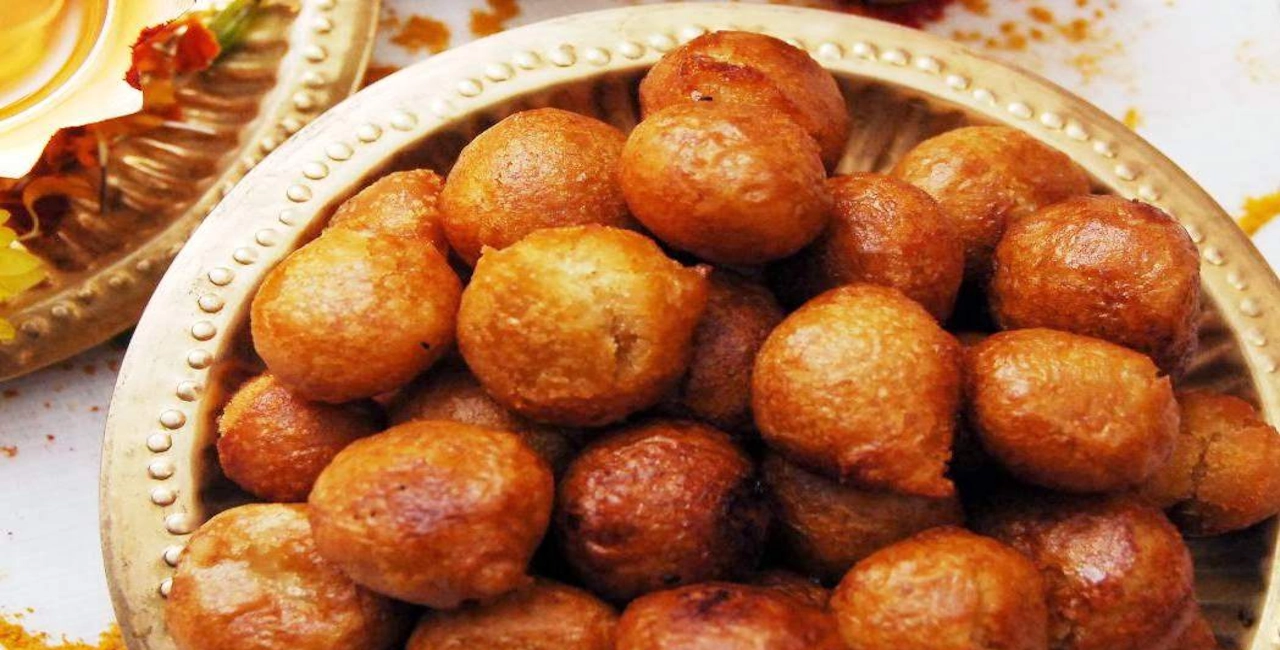Currently Empty: ₹0.00

Gulgula is a popular traditional sweet from Uttarakhand, deeply rooted in the culinary heritage of this Himalayan state. These sweet, deep-fried dumplings, made from wheat flour and jaggery, hold a special place in the hearts of locals and visitors alike. Simple in preparation yet rich in flavor, Gulgula is often enjoyed as a snack or dessert during festivals, fairs, or family gatherings. Its humble ingredients and rustic charm reflect the essence of Uttarakhand’s cuisine, which is deeply connected to the natural bounty of the region.
Origins and Cultural Significance
The origins of Gulgula can be traced back to the villages of Uttarakhand, where it has been prepared for generations. It is a dish that embodies the simplicity of mountain life, relying on basic ingredients like wheat, jaggery, and a handful of spices. Gulgula is often made during local festivals such as Harela and Basant Panchami, as well as during religious ceremonies. It is also served to guests during celebratory occasions, symbolizing warmth and hospitality.
In addition to its traditional role in festivals, Gulgula is often prepared in rural households as an everyday snack. The dish is particularly popular in the Kumaon and Garhwal regions, where families pass down the recipe through generations. For many, the sight and smell of Gulgula evoke fond memories of childhood, community celebrations, and the joy of sharing homemade sweets with loved ones.
Ingredients and Preparation
One of the appealing aspects of Gulgula is its simplicity. The key ingredients are:
- Wheat Flour: The base of the batter, wheat flour provides structure and gives the dumplings a slightly dense yet fluffy texture when fried.
- Jaggery: Used as a natural sweetener, jaggery not only adds sweetness but also gives the Gulgula a rich, caramel-like flavor. Its unrefined nature makes it a healthier alternative to refined sugar, aligning with the traditional, wholesome cooking of Uttarakhand.
- Fennel Seeds: These seeds add a mild, sweet aroma and a slight crunch to the dumplings, enhancing their flavor.
- Baking Soda: A pinch of baking soda helps the Gulgula puff up during frying, resulting in a light, airy texture.
- Water: Used to dissolve the jaggery and form a smooth batter.
- Oil or Ghee: For deep frying, which gives the dumplings their signature golden-brown color and crispy exterior.
To prepare Gulgula, jaggery is first dissolved in water, and then wheat flour, fennel seeds, and baking soda are added to form a thick batter. The batter is left to rest for a short while, allowing the ingredients to blend. Once the batter is ready, small portions are dropped into hot oil or ghee and fried until golden brown. The result is a batch of sweet, soft dumplings with a crispy exterior and a delicate flavor.
Some variations of Gulgula may include the addition of mashed bananas or yogurt to the batter, giving it a slight tang and enhancing its texture. These variations are particularly popular in certain regions and during specific festivals.
Nutritional Value
Gulgula is a relatively simple and wholesome snack. The use of jaggery as a sweetener provides several health benefits. Jaggery is rich in iron, calcium, and essential minerals, making it a healthier alternative to processed sugar. Wheat flour, the base ingredient, is a good source of fiber and carbohydrates, providing energy. The dish, when made in moderation with minimal oil, can be a nutritious option for a quick snack or dessert.
However, because Gulgula is deep-fried, it is important to consume it in moderation, particularly for those watching their fat intake. In Uttarakhand, Gulgula is often paired with hot tea or eaten as a standalone treat, making it a popular choice for breakfast or an evening snack.
Gulgula in Modern Times
While Gulgula remains a beloved traditional dish in Uttarakhand, it has also found its way into the kitchens of urban households across India and even abroad, as people from Uttarakhand have carried their culinary traditions with them. In recent years, the popularity of regional Indian cuisine has grown, leading to a renewed interest in traditional dishes like Gulgula.
In modern kitchens, Gulgula has seen a few adaptations. Some people experiment with adding cardamom, cinnamon, or even nuts to the batter to give it a more festive feel. Others may bake the dumplings instead of deep-frying them for a healthier version. Despite these innovations, the core essence of Gulgula—a simple, hearty sweet treat—remains unchanged.
For food enthusiasts exploring the flavors of Uttarakhand, Gulgula offers an authentic taste of the region’s culinary heritage. It is a dish that perfectly captures the balance between simplicity and flavor, making it a delightful addition to any meal.
Conclusion
Gulgula is more than just a sweet snack; it is a symbol of Uttarakhand’s rich cultural and culinary traditions. Whether made for festivals, offered to guests, or enjoyed as an everyday snack, these sweet dumplings carry with them a sense of warmth, nostalgia, and community. With its simple ingredients and traditional preparation, Gulgula continues to be cherished by both locals and visitors, connecting them to the rustic charm and wholesome flavors of the Himalayan region.


